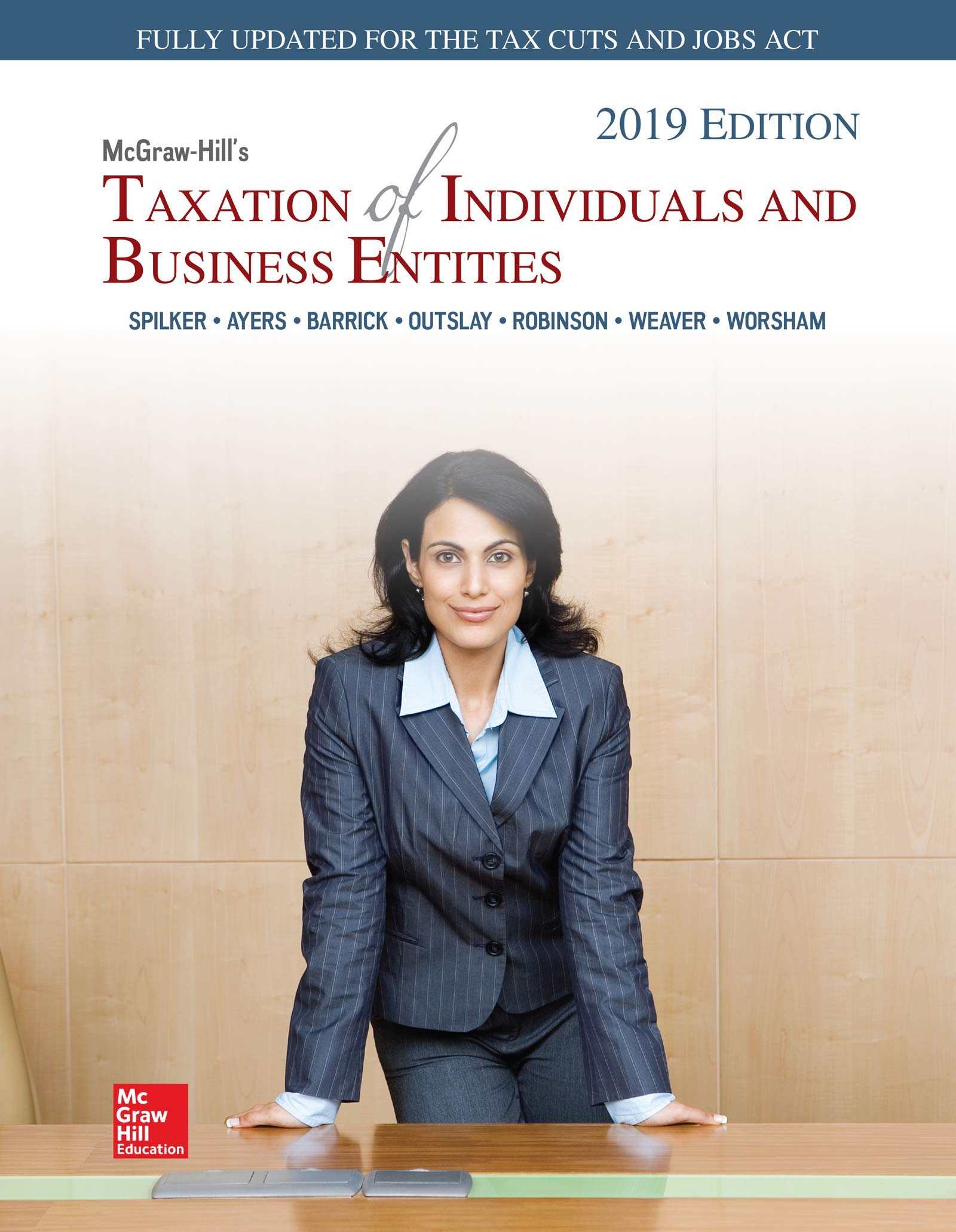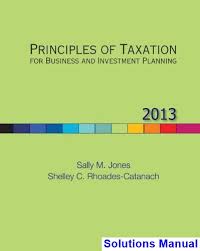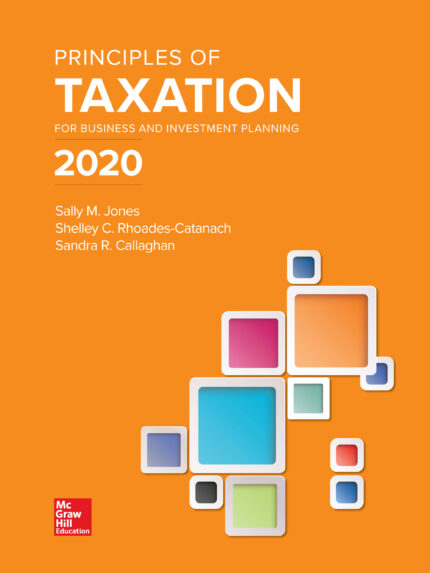Solution Manual for Taxation of Business Entities 2019 Edition 10th Edition by Spilker
Chapter 1
Business Income, Deductions, and Accounting Methods
SOLUTIONS MANUAL
Discussion Questions
- [LO 1] What is an “ordinary and necessary” business expenditure?
“Ordinary” and “necessary” imply that an expense must be customary and helpful, respectively. Because these terms are subjective, the tests are ambiguous. However, ordinary is interpreted by the courts as including expenses which may be unusual for a specific taxpayer (but not for that type of business) and necessary is not interpreted as only essential expenses. These limits can be contrasted with the reasonable limit on amounts and the bona fide requirement for profit motivation.
- [LO1] Explain how cost of goods sold is treated whena business sells inventory.
Under the return of capital principle, cost of goods sold represents a reduction in gross income rather than a business expense. For example, if a taxpayer sells inventory for $100,000 and reports a cost of goods sold of $40,000, the business’s gross income is $60,000 ($100,000 – 40,000) not $100,000.
- [LO 1] Whether a business expense is “reasonable in amount” is often a difficult question. Explain why determining reasonableness is difficult and describe a circumstance where reasonableness is likely to be questioned by the IRS.
Reasonableness is an issue of fact and circumstance, and extravagance is difficult to determine because of the subjectivity and multitude of factors involved in determining price. Reasonableness is most likely to be an issue when a payment is made to a related individual or the taxpayer enjoys some personal benefit incidental to the expenditure.
- [LO 1] Jake is a professional dog trainer who purchases and trains dogs for use by law enforcement agencies. Last year Jake purchased 500 bags of dog food from a large pet food company at an average cost of $30 per bag. This year, however, Jake purchased 500 bags of dog food from a local pet food company at an average cost of $45 per bag. Under what circumstances would the IRS likely challenge the cost Jake’s dog food as unreasonable?
A common test for reasonableness is whether the expenditure is comparable to an arm’s length amount – a price charged by objective (unrelated) individuals who do not receive any incidental personal benefits. Hence, the IRS is most likely to challenge the cost of the dog food if Jake’srelatives control or own the local pet food company and was benefiting from the increased price.
- [LO 2] What kinds of deductions are prohibited as a matter of public policy? Why might Congress deem it important to disallow deductions for expenditures that are against public policy?
The IRC lists bribes, kickbacks, and “other” illegal payments as nondeductible. Congress didn’t want the tax benefits associated with deductions to benefit or subsidize wrongdoing. Of course, this rationale doesn’t really explain the prohibition against deducting political contributions which is probably better explained by the potential perception that political efforts are being subsidized by taxpayers.
- [LO2] Provide an example of an expense associated with the production of tax-exempt income, and explain what might happen if Congress repealed the prohibition against deducting expenses incurred to produce tax-exempt income.
Two common examples are interest expense associated with debt used to purchase municipal bonds and life insurance premiums paid on key man insurance. If this prohibition were repealed, then taxpayers would have an incentive to borrow to invest in municipal bonds or borrow to invest in employee life insurance. This former practice would lead to higher demand for municipal bonds (less yield) and less revenue for the government. The latter practice would lead to higher demand for insurance (higher premiums?) and less revenue for the government. Both practices could lead to a perception of inequity between those taxpayers able to utilize the tax arbitrage to reduce taxes and those who could not use the practice.
- [LO 2] {Research} Peggy is a rodeo clown, and this year she expended $1,000 on special “funny” clothes and outfits. Peggy would like to deduct the cost of these clothes as work-related because she refuses to wear the clothes unless she is working. Under what circumstances can Peggy deduct the cost of her clown clothes?
Taxpayers may deduct the cost of uniforms or special clothing they use in their business when the clothing is not appropriate to wear as ordinary clothing outside the place of business. In Peggy’s case, the clown clothes are analogous to special uniforms or protective garments and could be deductible. See D. Techner, TC Memo 1997-498. Erhard Seminar Training, TC Memo 1986-526 provides an example of clothes that were not deductible because they were appropriate for normal wear. However, the cost of clothing would not likely be deductible if the clothes were unacceptable solely because of the taxpayer’s sense of fashion.
- [LO 2] Jimmy is a sole proprietor of a small dry-cleaning business. This month Jimmy paid for his groceries by writing checks from the checking account dedicated to the dry-cleaning business. Why do you suppose Jimmy is using his business checking account rather than his personal checking account to pay for personal expenditures?
Jimmy might be trying to reduce his bank charges by using one account for both personal and business expenditures, but he could also be trying to disguise personal expenditures as business expenses. By commingling business and personal expenditures, Jimmy will need to separate personal and business expenditures before claiming any business deductions.
- [LO 2] Troy operates an editorial service that employs two editors. These editors often entertain authors to encourage them to use Troy’s service. This year Troy reimbursed the editors $3,000 for the cost of meals and $6,200 for the cost of entertaining authors. Describe whether Troy can deduct the cost of the meals and entertainment.
To deduct any portion of the cost of meals as a business expense, the amount must be reasonable under the circumstances, an employee must be present when the meal is furnished, andthe meal must be directly associated with the active conduct of the taxpayer’s business. Similar to business meals, entertainment associated with business activities contains a significant element of enjoyment. The Tax Cuts and Jobs Act enacted in late 2017 made entertainment nondeductible as a business expense. Hence, if the authors are clients or potential clients, the expenses are reasonable in amount and connected with the conduct of business, then Troy should be able to deduct $1,500 (50% of the cost of the meals and none of the entertainment).
- [LO 2] Jenny uses her car for both business and personal purposes. She purchased the auto this year and drove 11,000 miles on business trips and 9,000 miles for personal transportation. Describe how Jenny will determine the amount of deductible expenses associated with the auto.
Because only the expense relating to business use is deductible, the taxpayer must allocate the expenses between the business and personal use portions. A common method of allocation is relative use. In this instance Jenny would calculate the business portion based upon the ratio of business miles to total miles (11/20 or 55 percent). She would then deduct the costs of operating the vehicle for business purposes plus depreciation on the business portion (55 percent) of the vehicle’s tax basis. Alternatively, in lieu of deducting these costs, Jenny may elect to deduct a standard amount for each business mile she drives. The standard mileage rate (54.5 cents per mile for 2018) represents the per-mile cost of operating an automobile (including depreciation or lease payments). Once Jenny has made this election, she must continue to use it throughout the life of the auto.
- [LO 1, LO 2] What expenses are deductible when a taxpayer combines both business and personal activities on a trip? How do the rules for international travel differ from the rules for domestic travel?
If the taxpayer has both business and personal motives for a trip, but the primary or dominant motive is business, the taxpayer may deduct the transportation costs to get to the place of business, but she may deduct only meals (50%), lodging, transportation on site, and incidental expenditures for the business portion of the travel. If the taxpayer’s primary purpose for the trip is personal, the taxpayer may not deduct transportation costs to travel to and from the location but the taxpayer may deduct meals (50%), lodging, transportation, and incidental expenditures for the business portion of the trip. For international travel in excess of one week, the taxpayer must allocate the cost of the transportation between personal (nondeductible) and business (deductible) activities. Taxpayers generally determine the nondeductible portion of the transportation costs by multiplying the travel costs by a ratio of personal activity days to total days travelling. Finally, remember that travel days are considered business activity days for both domestic and international travel.
- [LO 2] Clyde lives and operates a sole proprietorship in Dallas, Texas. This year Clyde found it necessary to travel to Fort Worth (about 25 miles away) for legitimate business reasons. Is Clyde’s trip likely to qualify as “away from home,” and why would this designation matter?
Besides the cost of transportation, the deduction for travel expenses includes meals (50%), lodging, and incidental expenses. However, travel expenses are only deductible if the taxpayer is away from home overnight while traveling. For this purpose, a taxpayer is considered to be away from home overnight if the trip is of sufficient duration to require sleep or rest. It’s likely that Clyde’s trip will not satisfy this condition and that he will not be able to deduct half the cost of meals and the entire cost of lodging.













